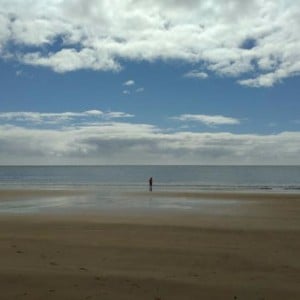12 Comment
Not only the capital of Portugal, Lisbon happens to be one of the oldest cities in the world. Predating Rome by hundreds of years, the city has, at various points in history, been ruled by Celtic and Germanic tribes, the Romans, the Moors and the Crusaders, and has barely survived fires and earthquakes. With such a rich history, and located directly at the mouth of the Tagus River by the Atlantic Ocean, it’s no wonder the city is home to amazing music, culture and food.
Rossio Square and the Mermaid FountainMy daughter and visited the city for two weeks. Although there is a great subway system, we mainly got around by walking to ensure we wouldn’t miss anything. One of our favorite hikes was along the Tagus River, stopping to take pictures of the street art, graffiti and multi-colored tiled homes. While other cities in Portugal have street art and might have streets or squares lined with tiled homes, nowhere is this as prevelent as in Lisbon. Below is a list of some of our favorite destinations:
1. Avenida da Liberdade
Nearly every day of our two week trip, my daughter and I walked along the Avenida da Liberdade. This boulevard, fashioned in the 19th century after the Champs-Elysees in Paris, runs for about a mile, bisecting major neighborhoods throughout the city. While today the boulevard is bustling with people coming and going from work, some of the old mansions were preserved, and the pavement, set with slippery (be careful!) stones in abstract, mosaic patterns, really is Lisbon at its best. Also, as we were visiting in the heat of summer, some areas of the boulevard, which are tree-lined and cool, were most welcome!
2. Jardim Gulbenkian
I have to confess, when we first arrived to Lisbon, I was suffering a terrible cold. Partner that with a heat wave, and I felt pretty miserable. The first few days of our trip, as well as the last few, my daughter and I took refuge in the Jardim Gulbenkian. Designed in the late 1950’s, the large, green spaces, the trails through wooded areas, benches along a lake filled with ducks, and even a wonderful, outdoor amphitheater with broad, cool places to sit, was perfect. My daughter enjoyed feeding the ducks, and then she snacked while I checked my email in the middle of the amphitheater (yes, I was able to connect to the Internet!). Even better, the garden was only a twenty minute walk from where we were staying in Bairro Alta.
Tower of Belem3. Belem Tower
This amazing UNESCO World Heritage Site, built during the Age of Discoveries in the 16th century on the Tagus River, was an important military fortification used to protect Lisbon from being attacked by ships. At various points in history, military personnel lived and worked in the fort, prisoners of state were contained in the cold belly of the building, and, astonishingly, a rhinoceros was once caged within the tower! My daughter and I had fun looking at a sculpture at the base of one of the turrets on the fort and seeing that it closely resembled a rhinoceros: no doubt it was inspired by what would’ve been- at least in 1515- a strange animal to see in Portugal! The tower is wonderful to explore, but a note to those who are either a little scared of enclosed places or heights: there are some areas that can only be reached by a thin, circular, rather frightening staircase. We just took our time, ignored other tourists who tried to rush us along, and thoroughly enjoyed ourselves.
4. Jeronimos Monastery
Yet another UNESCO World Heritage Site, the Jeronimos Monastery, originally built in 1459, is located only a ten minute walk from the Belem Tower. That said, I wouldn’t advise taking both sites in one day, as they are both pretty amazing, and worth exploring slowly. Richly ornamental in a style called Manueline, the monatery’s architecture, made of a golden-colored limestone, virtually shines in the sunlight. From the impressive main portal tombs and artwork contained within of the Church of Santa Maria to the cloisters of the monastery, proper, virtually everything about this structure is worth seeing. In addition, the monastery is located on park grounds, and my daughter delighted in seeing a few horse-drawn carriages carting tourists down the paths.
5. Padrao dos Descrobrimentos
It’s impossible to visit Lisbon with a kid and not teach her about the Age of Discoveries. Originally built in 1939, this huge monument, standing 171 feet tall alongside the the Tagus River, holds sculptures of 33 of Portugal’s most famous explorers, scientists, artists and other great men who face the river and the Atlantic Ocean. Notably missing are women: there is only one sculpture of a female, Queen Philippa of Lancaster. While the top of the monument can be reached by stairs of elevators, my daughter and I decided that the climb we took to the top of the nearby Tower of Belem probably afforded us better views of the area. Besides, we were quite content sitting in the shady side of the monument people watching for a bit.
More street art in Lisbon6. Rossio Square and the Mermaid Scuptures
Rossio Square, one of the main squares in Lisbon since the Middle Ages, used to host bullfights and executions. Today, it’s probably most popular for its mermaid sculptures. Designed and created by sculptors in France, the bronze sculptures that make up the mermaid sculptures were installed in the fountains in Rossio Square in 1889. On one end of the square rests the Palace of Estaus, which was where the Inquisition once had a tribunal that accused people of witchcraft. A fire destroyed the palace in the mid-1800’s, but was rebuilt within years, and today is used as a theatre. Sitting in the square sharing ice cream with my daughter, the square was a great place to talk about Lisbon’s dark history as well as delight in the playful mermaids.
7. Parque das Nacoes
Parque das Nacoes, a neighborhood in Lisbon that was transformed in the late 1990’s for the World Expo, is a wonderland for kids. My daughter and I spent the better part of a day running beneath a manmade waterfall in an area close to the water called Nation’s Park, and my daughter loved playing with sculptural toys in the adjacent public water park. Also enjoyable was to head for the Atlantic Pavilion, next to which stands a promenade of flags from around the world. Despite the glaring sun and hot day, it was fun to see how many flags we could identify. With plenty of lush, green spaces over which my daughter could run, this area of Lisbon, often neglected by tourists who want to explore some of the more historical neighborhoods, truly was a highlight.
8. Lisbon Oceanarium
Nestled within the Parque das Nacoes sits the Lisbon Oceanarium. My daughter and I decided to escape the heat for awhile and explore the exhibits. Besides having a variety of sharks, moray eels and dozens of other species, the main tank of the oceanarium holds a sunfish, a creature both strange in appearance and notoriously difficult to keep in captivity. We were lucky that we entered the otter exhibit at feeding time, and had a good time watching a man feed the frisky mammals fish. Another favorite area also included the penguin exhibit. It took us about two hours to walk through the museum, after which we got a bite to eat at an over-priced cafe. While we loved the oceanarium, if we were to go back in time, we definitely would’ve brought snacks with us, as the prices in the restaurants in the area definitely took advantage of tourists.
Tiled buildings in Lisbon9. Rua Augusta
Known as the best shopping area in Lisbon, this pedestrian street certainly has its share of shops and street peddlers. Not being the type who pick up a lot of souvenirs, my daughter and I declined to shop and instead enjoyed listening to street musicians sing sad, sweet songs. Although neither of us spoke Portuguese, it wasn’t hard to figure out that the singers were lamenting love lost. To be honest, Rua Augusta wasn’t our favorite site, as it was just too touristy for our liking, but we did like knowing that part of the Gulliver’s Travels film starring Ted Danson was shot there.
10. Comercio Square
Home to the royal palace until it was destroyed by the Great Earthquake of 1755, Comercio Square is a favorite meeting place of locals and tourists alike. Walking beneath the huge arch on the north side of the square, my daughter and I walked by a huge sculpture of King Jose I and across a huge, open expanse until we reached the Tagus River. There, we enjoyed the view and soaked in the sun for awhile before hunting for a place to eat. Luckily, there is no such thing as bad food in this neighborhood of Lisbon. Ask a local for his or her favorite spot, and order whatever you see the regulars eating. You won’t be disappointed.
Tips for Lisbon
The subway, while efficient and easy to use, does NOT run 24-hours a day. Make sure to check the times, and plan accordingly! The last thing you want to do is take an overnight bus from Spain, arrive to the bus station at the crack of dawn, and realize that the subways don’t start running until 6:30AM (yes, this did happen to me).
Food in Lisbon is really inexpensive! Make sure to try sardines and the custard-filled pastries sold in most pastry shops.
Posted anonymously, 14th January 2015














-

-
-
mom112217 said
- 27 Mar 2017
Reply
-

-
-
mom113055 said
- 22 Sep 2015

-

-
-
mom81879 said
- 14 Sep 2015
-

-
-
mom81879 said
- 14 Sep 2015
-

-
-
mom113055 said
- 07 Apr 2015

-

-
-
robyn_smithwick said
- 02 Feb 2015
-

-
-
hopefullyheidi said
- 31 Jan 2015
-

-
-
kymichelle said
- 31 Jan 2015
-

-
-
Bela said
- 31 Jan 2015
-

-
-
mom93821 said
- 18 Jan 2015
-

-
-
BellaB said
- 16 Jan 2015
Post a comment12:13 pm
3:59 pm
1:29 pm
1:28 pm
12:31 pm
4:02 pm
8:06 pm
5:08 pm
11:33 am
8:02 am
-

-
-
mom93821 replied
- 20 Jan 2015 , 6:52 am
Reply4:40 pm
To post a review/comment please join us or login so we can allocate your points.